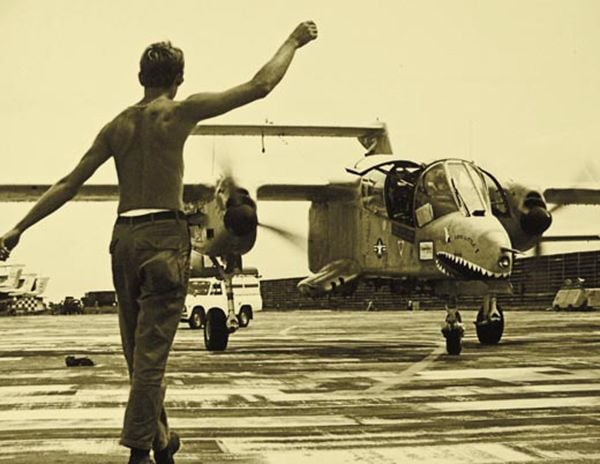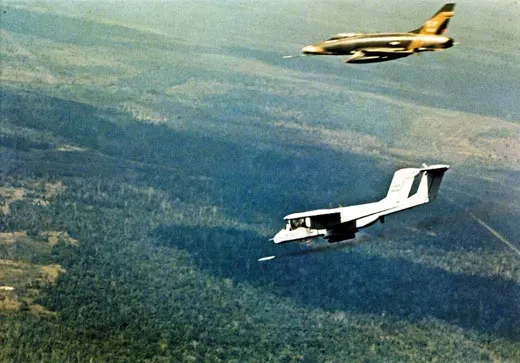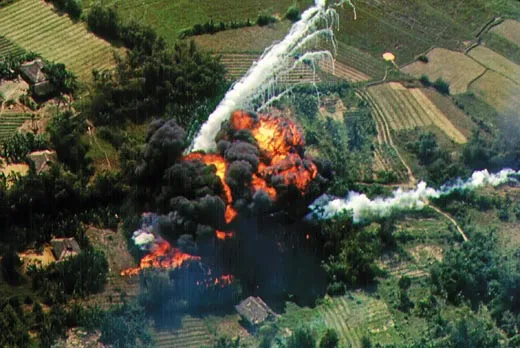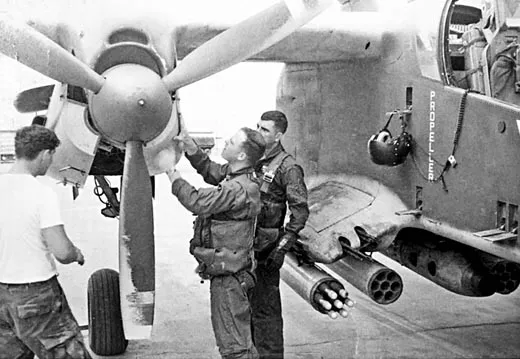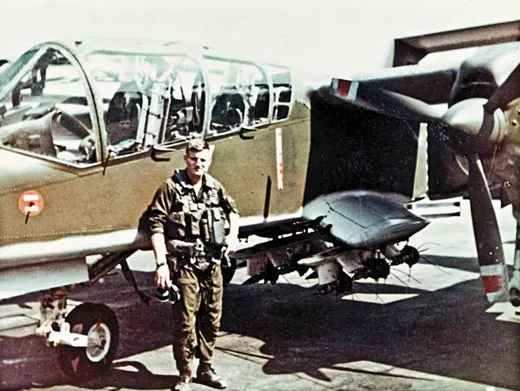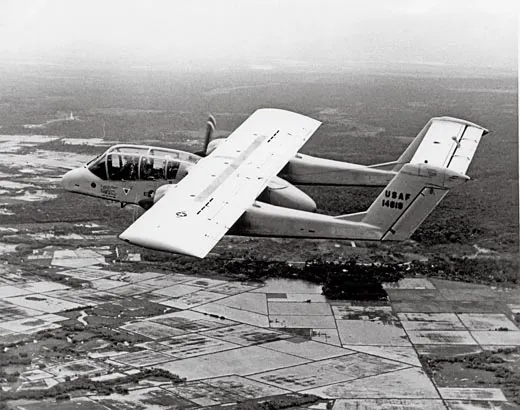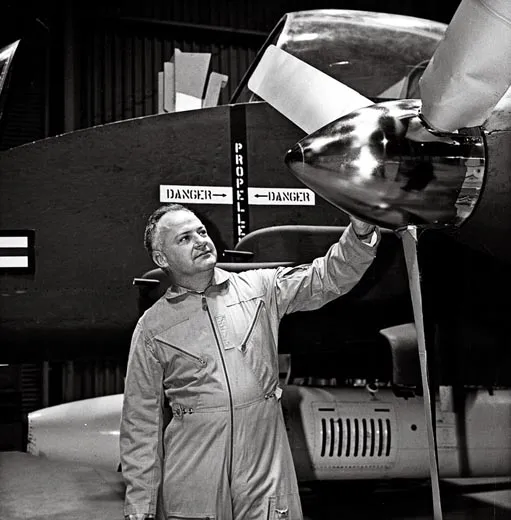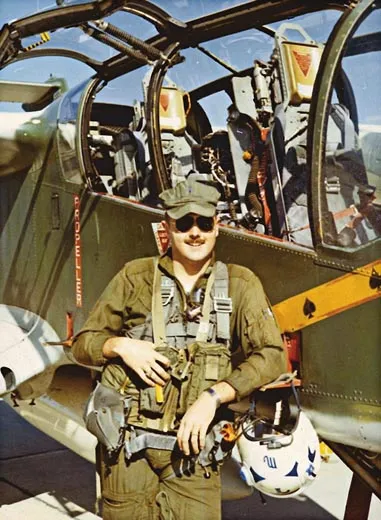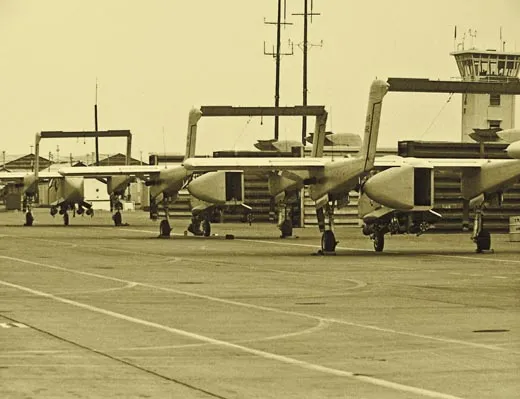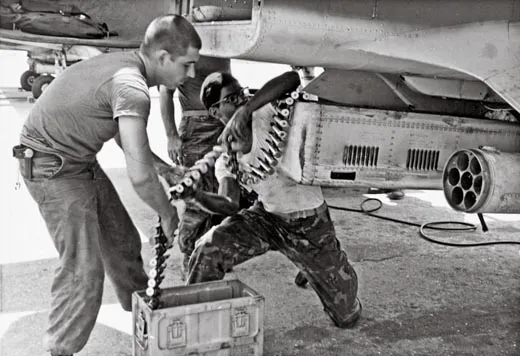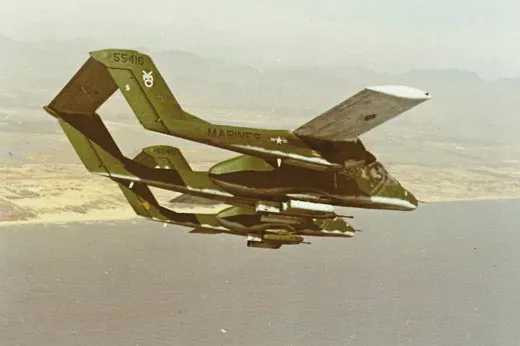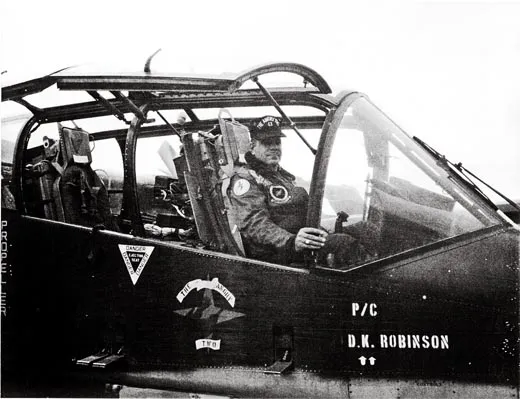Legends of Vietnam: Bronco’s Tale
One of the most versatile aircraft of the Vietnam War appears on the verge of a comeback
/https://tf-cmsv2-smithsonianmag-media.s3.amazonaws.com/filer/ab/04/ab041cc5-3a72-4d3f-8d85-893df4c8379d/bronco_gala_military_fm10.jpg)
The U.S. military has been here before: fighting an enemy who wears no uniform, one who hits and runs then disappears, blending in with local villagers. It has pursued before, with overwhelming technological superiority, guerrilla fighters who improvise weapons and use the terrain to hide. The rugged mountains along the Afghanistan-Pakistan frontier, where the Taliban and al Qaeda hide, are as effective at concealment as the dense swamps and forests of Vietnam, Laos, and Cambodia. In Vietnam, the U.S. military learned that when striking an elusive enemy, high-performance jet fighters were much more successful when they were directed by lighter, slower airplanes that could wait and watch for the enemy to move.
Last July the Air Force revived its requirement for a slow-moving, light-attack/armed reconnaissance aircraft, and Boeing’s Global Services and Support group responded with an updated version of a Vietnam veteran: the OV-10 Bronco. In Vietnam, the OV-10 (“O” for observation; “V” for short takeoff) was highly adaptable and performed many missions for the Air Force, Navy, and Marines. But it was primarily a forward air control aircraft whose machine guns, rockets, and bombs could quickly make it ferocious.
“You could do quite a bit of damage while you were waiting for the heavier stuff,” says Dennis Darnell, who in 1969 and 1970 was a first lieutenant in VMO-2, an observation squadron supporting the First Marine Division at Da Nang. “And if the situation was right, you wouldn’t even need the heavier stuff. You could get Medevac or troop transport helicopters in and pluck [U.S. infantry] out of difficult situations and that would be the end of it.” The OV-10 was armed with four 7.62-mm machine guns and a variety of external weapons. For the Marines, the ordinary load was four rocket pods: two with white phosphorous rockets for marking targets and two with 2.75-inch, folding-fin rockets for striking them.
In 1971, 15 Air Force OV-10s with the 23rd Tactical Air Support Squadron, based at Nakhon Phanom Air Base in northeastern Thailand, were modified with laser designation pods and LORAN (long-range navigation) systems. The modified OV-10s would join the effort to interdict troops and supplies moving on the Ho Chi Minh Trail, according to aviation historian Darrel Whitcomb, who flew those forward air control missions.
Forward air controllers, or FACs, are the flying equivalent of army scouts who range ahead of the main unit to locate the enemy and quickly report its location and strength. The FAC’s mission is to call in artillery, fighter-bombers, or naval gunfire to reduce or eliminate the threat.
The FACs with laser designators illuminated targets for McDonnell F-4 Phantoms, at the time the only aircraft in Southeast Asia equipped with laser-guided weapons. On the OV-10, the LORAN “talked to” the laser designation system, says Whitcomb, so that pilots would receive a readout in the cockpit of the coordinates of the illuminated target. “The weapons systems guy in the back seat would hold the designation system crosshairs on the target,” he says, “and the bomb would come down and it would guide right to the target.”
The control vanes on the bombs deflected fully or not at all, so the bombs would follow a zig-zag path. “I can still see it to this day,” says Whitcomb. “The bomb came off the F-4, and you could see it wobbulating—pitching up and down as it tracked to the target. Normally it took about 34 seconds to fall to the ground.”
The Bronco arrived in Vietnam in 1968. It didn’t take long for it to develop a reputation that made the Viet Cong think twice about shooting at it. “After a while, the enemy knew that it was a FAC aircraft,” says Darnell. “We got cut some slack because if they missed, [they knew that] within a few minutes we could bring the world down around their ears.”
“If a guy fired at us, the [pilot] would go into a steady orbit around the gun pit, and the bomb would come in,” says Whitcomb. “And the enemy realized that if they saw an OV-10 go into a standard left-hand turn”—the pilot’s maneuver to enable the backseater to designate the target—“they’d better stop shooting because they were about to get hit with a laser-guided bomb. And we used that as a defensive tactic: If they shot at you, just go into standard left-hand orbit.
“We lost some OV-10s doing that kind of stuff,” he adds.
The reluctance of the enemy to fire was sometimes frustrating to the pilots, who were prohibited by the rules of engagement from attacking certain targets in Vietnam unless the bad guys fired first. So the idea was to get them to shoot. Gordon Evans, a Marine first lieutenant in 1971, remembers flying a patrol 20 miles west of Da Nang when he spotted a group of about 10 North Vietnamese soldiers lined up on a dike. He made a close pass to get them to fire. Nothing. He went around again. “They just didn’t pay me any mind,” Evans says. “They knew what was going on. So I went around to make still another pass, real slow. My backseater got agitated and said, ‘I don’t think this is a good idea. We’re gonna get hosed.’ ” But there was still no fire from the men on the dike. “I was all of 24, bulletproof, and knew everything,” he says. “I dropped my gear and my flaps, put all the lights on in the airplane—this is daytime—and went by in a landing configuration” to make the best possible target. He finally elicited a response. “Several guys on the dike pulled down their trousers and mooned us,” Evans says.
In the Era of Boom and Zoom
The Bronco was developed through a process unique in military procurement history. Two Marine Corps majors, K. P. Rice and the late William H. Beckett, were neighbors in Santa Ana, California, in 1961. (“K.P.” stands for Knowlton Prentice, which is “great for a Congressman,” Rice says, but “lousy for a Marine.”) The two had been in a Corsair squadron together in 1949, and, sitting on Beckett’s patio, they would discuss the Navy and Air Force preoccupation with sleek, swept-wing fighters and exotic weapons during what Beckett called “the era of boom and zoom.” They believed that the services were ignoring conventional weapons necessary for the close air support of ground forces.
What was needed, Beckett and Rice determined, was a scrappy observation airplane that could not only find enemy combatants but also attack them on the spot. They envisioned a twin-engine turboprop that would be faster than helicopters, yet slower and more versatile than jets. And it had to be simple and easy to maintain. Furthermore—and this was revolutionary—the aircraft had to be capable of taking off and landing in so short a space that it could be stationed with battalions in combat areas, not at some far-off air base. Each battalion would in effect have its own small air force. The two would-be designers limited the wingspan to 20 feet and the distance between landing gear to six and a half feet so that the aircraft could land on and take off from roads in undeveloped areas.
“Why don’t we build one?” Rice finally asked his friend. The two men built as much of a full-scale fiberglass model as would fit in Rice’s garage (because of the space limitation, attaching the wings was out of the question), and then began trying to sell the concept to “The System,” as Rice scornfully called the 1960s decision makers in the Pentagon and the aircraft industry. Their design was met with deep skepticism, partly because, unlike other attack aircraft, it didn’t carry tons of bombs. “We don’t want to do that,” Rice and Beckett patiently explained. “We want to base it with the troops and carry infantry ordnance.” They had in mind the 106-mm recoilless rifle.
The Navy fought the project at first, Rice says, but eventually came around, and so did the Air Force. In 1963, the services began writing requirements for a Light Armed Reconnaissance Aircraft. The Navy required landing gear that would enable the aircraft to operate from rough areas, and to test that capability, built a runway that looked like a sine wave. In a 2009 video documentary (made as a thesis for a master of fine arts degree by a student at the University of North Texas), the OV-10 gamely bounces down the runway’s hills and valleys as Beckett describes the test results: “The best pickup truck could do something like 7 mph on it before it went completely out of control. The OV-10 was supposed to land and take off on that. And they could. The plane could do it, but the pilot couldn’t.” The aircraft shook so violently that the pilot’s vision blurred.
What was finally built—by North American Aviation, which, after a series of mergers, was later absorbed by Boeing—was a much larger aircraft (the wingspan doubled) with more systems than the two friends had originally planned. “But it was still recognizable,” says Rice. “It could still be a pretty useful airplane.”
As Rice and Beckett had stipulated, the wings were set behind the narrow, tandem cockpit but even higher than in the original design, so they would not block the view of the ground or of anything lurking above and behind the aircraft. And the canopy was wider than the cockpit and bulged, which made the view spectacular.
Ready, 24-7
Appropriately, the first six Broncos that went to Vietnam were sent by the Marines and flew their first missions on July 6, 1968. An Air Force contingent arrived on August 1 and began operational missions a couple of weeks later. The Navy sent Light Attack Squadron Four (VAL-4), the “Black Pony,” in April 1969 to provide close air support for its “brown water” river and coastal operations, attack Viet Cong supply routes, and provide fire support for the SEALs.
“We had an aircraft in the air from six o’clock in the morning until right after sunset,” says Chuck Burin, a Marine aviator with VMO-2 in Da Nang who on a previous tour had flown A-4 Skyhawks. Today, Burin is the chairman of the board and historian of the OV-10 Bronco Association, a group of 400 veterans and Bronco fans headquartered in Fort Worth, Texas. The group has restored two Broncos for a museum displaying forward air control aircraft and memorabilia at Fort Worth Veterans Memorial Air Park at Meacham Field. One of them is an OV-10A that both Burin and Dennis Darnell flew in Vietnam.
With aircraft aloft all day—and crews on standby for night missions—a Marine OV-10 was always ready to support troops coming in contact with enemy forces. “We’d always have a crew on the ‘hot pad,’ as they called it, ready to go,” says Michael Cerre, a Marine tank officer who flew as an aerial observer. Marines who flew in the Bronco back seats were not aviators; instead they were infantry, artillery, or tank officers “who knew how to talk to guys on the ground,” Darnell says.
"On very-heavy-activity nights, we were sleeping under the wing of the plane,” says Cerre. “I can remember we used to wear [on lanyards] around our necks little plastic cheat sheets with the last coordinates we had for reconnaissance teams, so if they’d wake us to say, ‘You’re scrambling to support team Jolly Roger,’ I’d look down and the coordinate was right on my chest. We didn’t want to waste a second. While the pilot was doing everything he had to do to get us off the ground, he’d say, ‘Where we going?’ ”
The observer would be busy pinpointing the coordinates on a map and working the radios to find the fastest and safest route to the destination—around, over, or under artillery fire. “It was a really intense period of listening to a lot of voices from a lot of sources,” Cerre says, adding that the experience helped him in his later career. As a broadcaster, “I’d have that link in my ear listening to the director yelling in all kinds of things and it was easy,” he says. “It was only two people speaking.” As a Marine observer in Vietnam, he had four radios, and was accustomed to hearing a lot more than two.
“The backseater could do what several radio operators on a C-130 could do,” adds Jim Hodgson, who also flew the aircraft and is the executive director of the OV-10 Bronco Association.
The job was “locating the ground force,” says Darnell, “isolating them on the maps, finding out what kind of a jam they had gotten themselves into, and then orchestrating whatever support was available at the time.” When there was no action, a crew was assigned to a specific area for daily recon missions so they could become intimately familiar with it, and report any changes to the intelligence officers. “It was amazing that after a while you could tell if a stream crossing had been used or if vegetation had changed,” says Darnell.
Says Burin: “You’d notice everything: The farmers aren’t out in the field today. Why is that?”
With external fuel tanks, an OV-10 could fly for five and a half hours. In addition to the four machine guns, which were mounted in sponsons bolted to the fuselage, there was a centerline station for a 20-mm cannon. The aircraft could carry up to 2,400 more pounds of rockets, bombs, or missiles on the sponson attach points.
“For those of us right out of pilot training, it was a slug compared to the T-38,” says former Air Force pilot Brad Wright, “but boy, was it nimble. You could turn on a dime and make change. It wasn’t sleek like a fighter jet, but it was plenty functional. It was a fun airplane to fly. It was responsive, fully aerobatic, had great visibility and good fuel economy.” Like other OV-10 pilots, though, Wright says that the aircraft was seriously underpowered.
“You always want more power,” says Burin. “I think the guys flying the F-22 want more power. But a number of OV-10s were lost in sloping terrain because they just couldn’t fly out of it. And if you lost an engine,” he continues, “if you didn’t dump everything that was hanging on that airplane, you were going to crash.”
Although the maximum altitude in the airplane’s published specifications is 26,000 feet, Broncos could work from the treetops up to only 18,000 feet “in optimum conditions,” according to Burin, “but we rarely flew above 10,000 feet.” Likewise, the aircraft could be considered a short-takeoff-and-landing craft, but it could take off in the advertised 800 feet only “with a light load on a cool day,” Burin says.
The Marine Bronco drivers and their backseaters ordinarily flew at 1,000 or 1,500 feet, so were most threatened by ground fire. The Air Force flew higher, at around 4,000 to 5,000 feet. “They had a lot more stuff shooting at them,” says Burin, referring to flights over the Ho Chi Minh Trail.
“At the start of the year I was concerned about [being hit by ground fire], but I guess I got over it,” says Jack Thompson, who was an FAC in Vietnam in 1971 and 1972. “It was almost a daily thing. I was there a year and I flew 234 missions, and so you get used to it. And the airplane, it’s like it was a part of me. It was slow and responsive.”
It wasn’t as slow as helicopters. Dennis Darnell, who also flew helicopters in Vietnam, much preferred the OV-10. “A lot of times if you were checking out, you’d go high and dive, and go by at a tremendous speed—a luxury you didn’t have in helicopters,” he says. “You were just always slow in those things. The reason I was so pleased with the OV-10 is I never had to put one in because of battle damage; whereas in four months, on my first tour I lost three helicopters.”
When a Bronco did need repairs, the work could be done with ordinary hand tools. In addition, no ground equipment was needed to start OV-10 engines; and in an emergency, high-octane automobile fuel could be used in place of aviation fuel with only a slight loss of power.
The airplane did have a vulnerability, however: No Bronco pilot ever ditched the aircraft and survived. Aware that a pilot had been killed in an attempted ditching, Air Force Captain Steven L. Bennett chose to try anyway: in late June 1972 after a surface-to-air missile damaged his left engine and left landing gear. Bennett made the decision because the missile blast had destroyed the parachute of his observer, Marine Captain Mike Brown. Darrel Whitcomb was attacking enemy targets near the Demilitarized Zone when he got a call from Bennett. Whitcomb rendezvoused with the stricken aircraft and watched as it came down just off the South Vietnam coast. “By the time the helicopter got there,” says Whitcomb, “they were able to rescue the backseater, but Bennett was killed.” Bennett was the only OV-10 airman to receive the Medal of Honor.
What kept Bronco crews awake at night, says Michael Cerre, was the fear of directing an air strike or artillery strike on friendly forces or on civilians. “Was it the wrong bend in the river?” he remembers thinking right after the bombs had been released. “Was it the wrong hooch?”
“For the recon troops, we were calling for air strikes within 100 meters of them and that was terrifying,” says Cerre. “The jets would be coming in—they had to make these steep, tight turns—and the pilot would be saying ‘Am I cleared?’ but their wings would still be rocking and I’d answer ‘Negative, negative, negative’ because I had to make sure that the pilot had steadied his wings and had his sights on that target.
“And then there was this moment that haunts me to this day. [After the bomb was released] the radios would go silent. And you hope you hear the ground troops say, ‘We’re okay,’ or ‘That was on target.’ But sometimes it wouldn’t be okay. Either there was terror in their voices because the bomb had hit so close or the enemy was still coming.”
Old Bronco, New Tricks
On February 23, 1991, the night before the Operation Desert Storm ground assault officially began, the First and Second Marine Divisions were already inside occupied Kuwait, breaching the minefields that Iraqis had laid. A holdover from the war in Vietnam was with them. Above the advancing Marines, an OV-10D—a Bronco with upgraded engines and a night vision system—monitored the ground action. The lead battalion, new to combat and moving fast in the dark, called in air support that could have hit friendly positions nearby. Captain Kevin Trepa, the Bronco observer who had a more complete picture of the battlefield, intervened and almost certainly prevented fratricide.
After Desert Storm, the Marine Corps decided to retire the OV-10 because its slow speed made it vulnerable to anti-aircraft weapons. (Of the 20 deployed in Desert Storm, two were shot down, both A models.) A flurry of articles in the Marine Corps Gazette worried that no airplane remaining in the inventory could perform the same mission as well. The Air Force’s recent call for proposals seems to validate that belief, at least in those combat areas without sophisticated air defenses.
Mark Pierce is leading Boeing’s business development effort with the OV-10(X). “In theaters where the air defense threat has been peeled back,” he says, “this would be a perfect platform to do convoy support or light-attack/armed reconnaissance at a fraction of the cost of what the [services] have been doing through F/A-18s, F-16s, F-15s, and A-10s.” Though it would still be the same simple airframe, it would have a fully computerized cockpit, intelligence sensors, and a 30-mm gun in a centerline pod. It could also carry smart bombs and up to 16 Hellfire missiles.
Boeing is planning for a world market and hopes to sell upgrades to countries that have bought new and previously owned Broncos: Germany, Thailand, Venezuela, Indonesia, Colombia, and the Philippines. In the meantime, more than a few Bronco pilots and observers believe that if the U.S. Air Force needs a light-attack/armed reconnaissance aircraft, the one that performed the missions so successfully in Vietnam should report for duty.
William E. Burrows is an Air & Space contributing editor.
